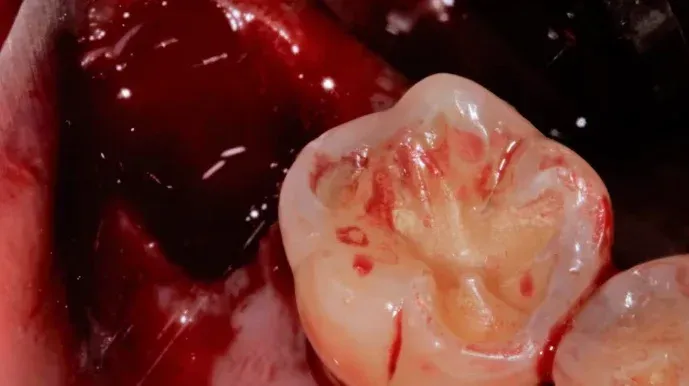Gum Hurts Where Wisdom Tooth Was Removed Years Ago: Here’s What to Do
Wisdom tooth extraction is a common dental procedure, often done to prevent potential dental issues. While…
Wisdom tooth extraction is a common dental procedure, often done to prevent potential dental issues. While the recovery process is typically smooth, some individuals may experience gum pain in the area where their wisdom tooth was removed, even years after the extraction.
This lingering discomfort can be concerning and may have various underlying causes. In this comprehensive guide, we will explore the possible reasons for gum pain years after wisdom tooth extraction, how to identify specific issues, available treatments, prevention strategies, and when it’s crucial to seek professional dental care.
Possible Causes of Gum Pain After Wisdom Tooth Extraction:
Experiencing gum pain years after wisdom tooth extraction can be attributed to several factors, including:
1. Residual Root Fragment:
- Sometimes, a fragment of the wisdom tooth’s root may remain in the gum tissue after the extraction. This can cause irritation, pain, and discomfort over time.
2. Bone Spurs:
- Bone spurs are small, sharp projections of bone that can develop in the socket where the wisdom tooth was removed. These can cause pain and irritation, particularly when the gum tissue rubs against them.
3. Infection:
- Infections can develop in the gum tissue or socket years after the extraction. Bacterial growth in the area can lead to inflammation, pain, and swelling.
4. Recurrent Cyst or Tumor:
- Although rare, cysts or tumors can develop in the area where a wisdom tooth was removed years later. These growths can cause pain, discomfort, and swelling.
How to Tell If You Have a Residual Root Fragment:
A residual root fragment is a fragment of the wisdom tooth’s root that remains in the gum tissue after the extraction. Some signs and symptoms of a residual root fragment may include:
- Persistent pain or discomfort in the extraction site.
- A sensation of something sharp or foreign in the gum tissue.
- Swelling or tenderness in the area.
If you suspect you have a residual root fragment, it’s crucial to see your dentist for evaluation and treatment.
Treatment for a Residual Root Fragment:
Treatment for a residual root fragment typically involves:
- Dental Imaging: X-rays or other dental imaging may be taken to locate and assess the fragment’s position.
- Surgical Removal: If a fragment is identified and causing pain or discomfort, your dentist may recommend a minor surgical procedure to remove it.
- Pain Relief: Over-the-counter or prescription pain relievers can help manage discomfort during and after the procedure.
- Follow-up: You may need to return to the dentist’s office for follow-up appointments to ensure proper healing.
When to See a Dentist:
If you experience gum pain years after wisdom tooth extraction, it’s essential to see a dentist when:
- Pain is persistent, severe, or worsening.
- You notice signs of infection, such as swelling, redness, or discharge.
- You suspect the presence of a residual root fragment or bone spur.
- There is a visible lump or unusual changes in the gum tissue.
- You have concerns about the ongoing discomfort or any complications.
Regular dental check-ups can also help detect and address issues before they become more severe or painful.
How to Prevent Gum Pain Years After Wisdom Tooth Extraction:
Preventing gum pain years after wisdom tooth extraction involves several strategies:
- Oral Hygiene: Maintain good oral hygiene by brushing, flossing, and using an antiseptic mouthwash regularly. Proper oral care can help prevent infections and reduce the risk of complications.
- Regular Dental Check-ups: Schedule regular dental check-ups and cleanings to monitor the healing of the extraction site and address any concerns promptly.
- Follow Post-Extraction Instructions: Adhere to your dentist’s post-extraction care instructions, including avoiding certain foods, smoking, or using straws during the initial recovery period.
- Address Any Concerns Promptly: If you experience any pain, discomfort, or unusual changes in the gum tissue or extraction site, consult your dentist promptly for an evaluation.
- Avoid Smoking or Tobacco Products: Refrain from smoking or using tobacco products, as they can interfere with healing and increase the risk of complications.
- Maintain a Balanced Diet: Consume a balanced diet that includes foods rich in vitamins and minerals necessary for oral health.
Conclusion
Gum pain years after wisdom tooth extraction can have various causes, ranging from residual root fragments and bone spurs to infections and rare occurrences like recurrent cysts or tumors. If you experience ongoing discomfort in the area of a previous wisdom tooth extraction, it’s crucial to pay attention to your symptoms, seek professional dental care when necessary, and follow your dentist’s advice for appropriate treatment and prevention. Regular dental check-ups can also help catch and address any potential issues before they become more severe or painful, ensuring your ongoing oral health and comfort.







